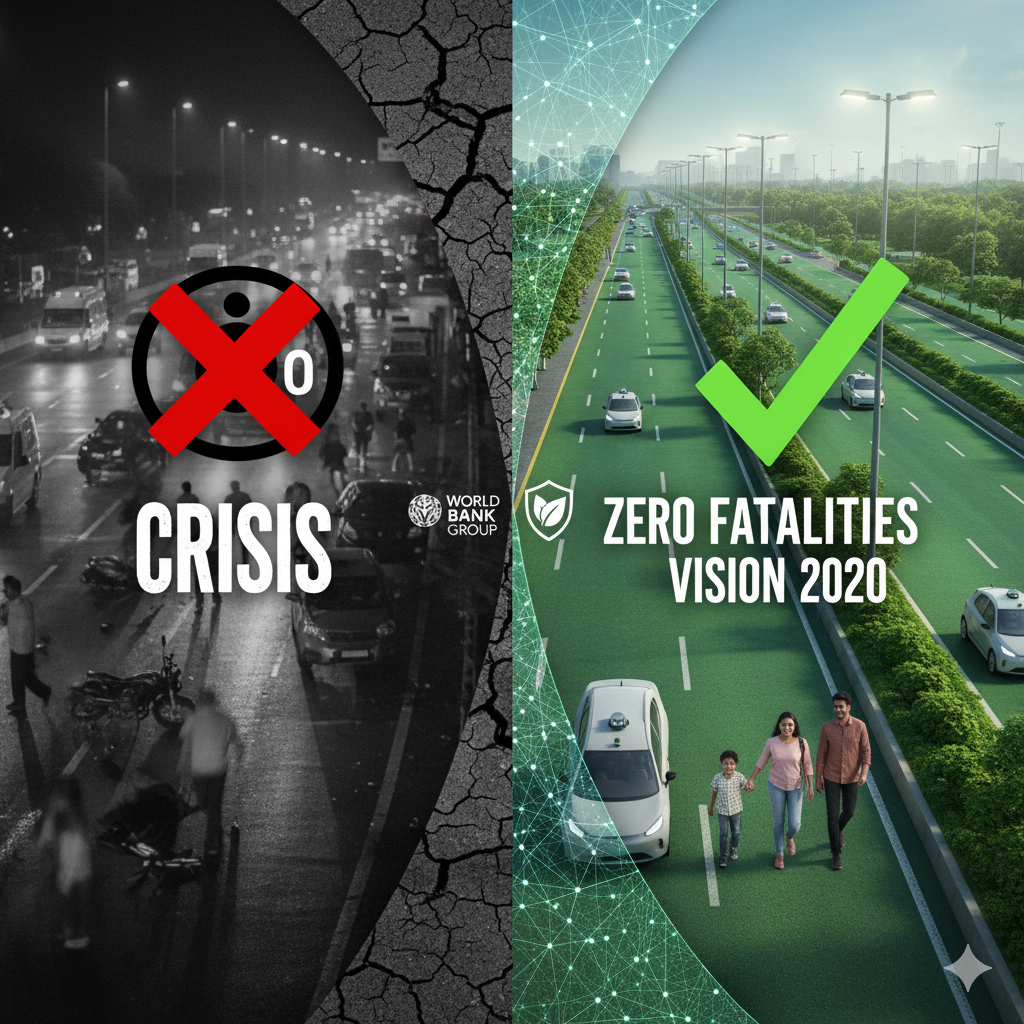Key Highlights
- Alarming Scale: India accounts for 11% of global road crash fatalities with over 1.73 lakh deaths in 2023, creating a 3% GDP drain annually
- Highway Danger: National highways comprise just 2% of road network but account for over 30% of road deaths, with 29,018 fatalities in first half of 2025 alone
- Vulnerable Users Crisis: 54% of fatalities involve pedestrians, cyclists, and two-wheeler riders, with two-wheelers alone contributing 36% of crash deaths
- Legislative Response: Motor Vehicles Amendment Act 2019 showing early success with 40-41% mortality decline in implementing states
- Massive Investment: $2 billion State Road Safety Incentives Programme targeting 14 states responsible for 85% of road fatalities

The Magnitude of India’s Road Safety Challenge
India faces a road safety crisis of unprecedented proportions that demands immediate and sustained action. With over 1.73 lakh road deaths reported in 2023, the country bears the tragic distinction of accounting for 11% of global road crash fatalities despite having only 17% of the world’s population. pib.gov
The first half of 2025 has already witnessed 29,018 deaths on national highways alone – a figure representing more than 50% of the previous year’s total highway fatalities. This alarming trajectory suggests 2025 could become one of the deadliest years on record unless immediate corrective measures are implemented.
The economic burden is staggering. India loses approximately 3% of its GDP annually to preventable road accidents, with 69% of fatalities comprising the working-age population between 18-45 years. This demographic devastation strikes at the heart of India’s economic potential, erasing productive lives and creating cascading effects on families and communities.
Understanding the Vulnerability Divide

The distribution of road deaths reveals a troubling pattern of vulnerability that exposes fundamental flaws in India’s transportation ecosystem. Vulnerable road users – pedestrians, cyclists, and two-wheeler riders – account for 54% of all fatalities and serious injuries, highlighting the inadequate protection afforded to the most exposed road users. gujrosa.gujarat
Two-wheeler riders face particularly acute risks, representing 36% of crash fatalities while simultaneously being responsible for 48,818 deaths in accidents they caused during 2023. This dual vulnerability as both victims and contributors to road crashes underscores the complex nature of India’s traffic safety challenges.
Pedestrian deaths have shown an alarming upward trajectory, rising from 25,858 in 2019 to 35,221 in 2023 – translating to 96 pedestrian fatalities every day. Tamil Nadu reported the highest pedestrian deaths (1,796) in two-wheeler-related crashes, followed by West Bengal (938) and Bihar (865).
Rural areas bear a disproportionate burden, accounting for 66% of all road deaths despite having lower traffic volumes than urban centers. This rural-urban divide reflects inadequate infrastructure development, limited emergency medical services, and insufficient enforcement in remote areas.
Motor Vehicles Amendment Act 2019: A Paradigm Shift

The Motor Vehicles Amendment Act 2019 represents India’s most comprehensive attempt to address road safety through legislative reform. Moving beyond the traditional focus on vehicle registration and penalties, the MVAA introduces a holistic safety framework aligned with international best practices and UN vehicle safety standards.
Early impact assessments reveal promising results. States implementing the MVAA have reported 40-41% declines in road mortality, demonstrating the legislation’s potential when properly enforced. Helmet usage increased dramatically from 18% to 42%, while alcohol-related driving incidents dropped from 25% to 10%. pwc
The Act’s innovations extend far beyond penalty increases. It establishes unprecedented accountability mechanisms, holding road agencies, contractors, consultants, and concessionaires responsible for non-compliance with safety standards. This shared responsibility approach recognizes that road safety requires systemic change across all stakeholder categories.
Technology integration forms a cornerstone of the MVAA’s enforcement strategy. The Act mandates electronic monitoring systems, streamlined digital services, and automated testing provisions while introducing vehicle recall powers and advanced safety feature requirements.
Vision Zero 2030: India’s Ambitious Safety Mission

India’s National Road Safety Strategy (2018-2030) embraces the Vision Zero philosophy – an ambitious commitment to reducing road fatalities to zero through systematic, evidence-based interventions. This approach recognizes that no loss of life is acceptable on roads and that crashes are preventable through proper system design.
The strategy identifies ten pillars for comprehensive action across three implementation phases, requiring coordination between transport, enforcement, health, education, urban development departments, and private sector stakeholders. This multi-sectoral approach acknowledges that road safety transcends traditional departmental boundaries.
Recent developments have accelerated implementation momentum. Union Minister Nitin Gadkari’s proposed National Road Safety Mission and Road Safety Plan-2025 aims to achieve the ambitious target of cutting road crashes by 50% by 2030 and reaching near-zero fatalities by 2047. This aligns with India’s centenary independence celebrations while addressing one of the nation’s most pressing public health crises.
The Zero Fatality Attainment (ZFA) approach now guides National Highway Authority of India operations. Around 1,083 High Fatality Zones have been identified across 77 National Highways, with targeted engineering interventions planned for 6,948 critical spots.
The State Incentives Revolution
India’s State Support Programme for Strengthening Road Safety represents the world’s largest performance-based road safety investment, targeting $2 billion over six years. This landmark initiative focuses on 14 states accounting for 85% of national road fatalities: Uttar Pradesh, Maharashtra, Madhya Pradesh, Karnataka, Rajasthan, Tamil Nadu, Andhra Pradesh, Gujarat, Bihar, Telangana, West Bengal, Odisha, Haryana, and Assam. adb.org
The financing structure demonstrates unprecedented international cooperation. The World Bank contributes $250 million, the Asian Development Bank provides another $250 million, with India matching the total for a $1 billion program envelope. This collaborative approach leverages global expertise while ensuring national ownership. documents1.worldbank
Performance-based disbursement mechanisms ensure accountability and results. States receive annual assured budgets proportionate to their road safety burden, with funding tied to achieving mandatory and optional Key Performance Indicators covering road engineering, vehicle safety, enforcement, and post-crash care.
The program’s outcome-focused design targets a 30% reduction in fatalities by 2028, with 90% of funds flowing directly to state-level implementation and 10% reserved for capacity building activities. This results-driven approach moves beyond traditional input-focused development programs.
Five Pillars Framework: UN Global Plan Integration
Pillar 1: Road Safety Management and Leadership
India’s institutional architecture for road safety has evolved significantly, though gaps remain in implementation effectiveness. The National Road Safety Council currently serves as the apex body but lacks adequate statutory backing, technical capacity, and resources. The Supreme Court has mandated establishment of the National Road Safety Board within six months, recognizing the urgency of strengthening institutional mechanisms.
Data systems improvement shows promising progress with uniform crash recording formats adopted by all states covering 55 fields in the Inter-Operable Criminal Justice System. Tamil Nadu and Himachal Pradesh lead with advanced Road Accident Database Management Systems, while Uttar Pradesh has deployed web-enabled databases.
Pillar 2: Safer Roads and Infrastructure
The MVAA uniquely holds road agencies accountable for safety standard compliance, introducing shared responsibility between designers and road users. This represents a fundamental shift from viewing crashes as inevitable “accidents” to recognizing them as preventable system failures.
Infrastructure safety assessments using International Road Assessment Programme (iRAP) methodology are being scaled up nationwide. The World Bank project includes indicators for qualified road safety risk assessments to identify high-risk corridors and sites.
Speed management emerges as a central priority spanning infrastructure, vehicle, and road user safety interventions. Scientific evidence demonstrates that appropriate speed limits significantly reduce crash fatalities and injuries when combined with infrastructure modifications and systematic enforcement.
Pillar 3: Safer Vehicles
India has strengthened vehicle safety regulations to comply with 6 of 8 UN vehicle safety standards, with provisions for vehicle and component recalls supplementing mandated safety requirements. Anti-Lock Braking Systems (ABS) mandates and electronic stability control requirements represent significant advances in vehicle safety technology.
Global New Car Assessment Program (GNCAP) and Automotive Research Association of India (ARAI) testing standards provide independent safety evaluations, helping consumers make informed decisions while incentivizing manufacturers to prioritize safety features.
Pillar 4: Safer Road Users
The MVAA addresses critical behavioral risk factors including helmet and seatbelt non-compliance, speed violations, and vehicle occupancy breaches. Post-implementation improvements show helmet usage rising from 18% to 42% and significant reductions in alcohol-related driving incidents.
Electronic monitoring systems on highways and urban roads ensure enforcement transparency while building deterrence-based compliance culture. However, implementation challenges persist, with many states reducing maximum penalties citing concerns about corruption and administrative burden.
Pillar 5: Post-Crash Care
The Motor Vehicle Accident Fund provides cashless treatment for crash victims during the critical “golden hour” following accidents. Minimum compensation has increased substantially: ₹2 lakh for deaths and ₹50,000 for grievous injuries, with enhanced support for hit-and-run victims.
Good Samaritan protection provisions address public reluctance to assist accident victims, while enhanced emergency medical services and trauma care infrastructure improve survival rates.
Economic Imperatives: The Cost of Inaction vs Investment
India’s road safety challenge represents both a massive economic burden and an unprecedented opportunity for GDP enhancement. Research indicates that achieving 50% fatality reduction would result in 14% GDP increase over 24 years, with population welfare gains equivalent to 16.3% of GDP.
The investment requirement of $109 billion over the coming decade to achieve SDG targets appears daunting but represents a fraction of current economic losses. When contextualized against annual GDP losses of 3% due to road accidents, this investment delivers exceptional returns through preserved human capital and enhanced productivity.
Co-benefits extend beyond direct safety outcomes, including transport productivity improvements, universal accessibility, climate change mitigation, reduced air and noise pollution, and contributions to multiple Sustainable Development Goals.
Vulnerable Road User Protection: Critical Implementation Focus
Pedestrian safety requires urgent prioritization given the daily toll of 96 deaths. The Supreme Court’s recent 35-point order mandating compliance with Indian Road Congress standards represents a watershed moment for infrastructure accountability. All new and upgraded roads must now adhere to IRC codes, with failure to comply attracting fines up to ₹1 lakh.
Two-wheeler safety interventions must address the dual challenge of riders as both victims and contributors to road crashes. With 45% of road deaths involving two-wheeler riders and these vehicles causing 48,818 fatalities in 2023, comprehensive strategies encompassing infrastructure, enforcement, and behavioral change are essential.
Rural road safety demands specialized attention given that 66% of deaths occur in rural areas. This requires adapting urban-focused safety interventions to rural contexts, strengthening emergency medical services accessibility, and addressing unique rural traffic patterns.
Implementation Challenges and Sequencing Priorities
Institutional capacity constraints remain the most significant implementation barrier. Federal structure dynamics require careful coordination between central, state, and local governments, with large proportions of activities implemented by states lacking adequate resources and technical expertise.
Systematic implementation at scale rather than piecemeal interventions is essential for achieving meaningful impact. This requires proper sequencing: strengthening institutional capacity before scaling initiatives, building robust licensing systems before full compliance enforcement, and developing infrastructure safety design skills before major construction programs.
Data and monitoring systems need substantial strengthening to inform evidence-based policy decisions. National road safety data systems remain inadequate for guiding public policy, requiring standardized crash monitoring and performance measurement frameworks.
Global Context and SDG Alignment
India’s road safety efforts align with Sustainable Development Goal 3.6, which aims to halve global road deaths by 2030. The country’s commitment under the Stockholm Declaration and participation in the UN Decade of Action for Road Safety 2021-2030 demonstrates international cooperation in addressing this global challenge.
Regional partnerships through initiatives like the Asia-Pacific Road Safety Observatory facilitate knowledge sharing and best practice dissemination. India’s scale and diversity position it as a potential regional leader in road safety innovation, particularly in managing heterogeneous traffic conditions unique to South Asian contexts.
Policy Recommendations and Way Forward
Immediate priorities must focus on implementing existing frameworks rather than creating new policies. The National Road Safety Strategy and MVAA provisions require urgent implementation at national, state, district, and municipal levels. Formal agreements with state governments for MVAA compliance and launching the State Road Safety Incentives Programme on mission mode are essential first steps.
Institutional strengthening through establishing the National Road Safety Board and state counterparts with adequate powers and resources represents a critical foundation for sustained progress. The Supreme Court’s six-month deadline for Board constitution creates both opportunity and accountability for central government action.
Technology deployment including nationwide IRAD implementation, electronic enforcement system scaling, and infrastructure safety audit acceleration using iRAP methodology can deliver rapid improvements in safety outcomes.
Long-term vision alignment with Vision Zero 2030 and India’s 2047 centenary aspirations requires sustained multi-sectoral coordination, integration with sustainable mobility goals, and establishment of India as a regional road safety leader.
The Path to Zero: Building Safer Roads for Future Generations
India stands at a critical juncture where decisive action in the next five years will determine whether the nation achieves its Vision Zero 2030 objectives or continues experiencing unacceptable levels of road trauma. The convergence of legislative frameworks, institutional capabilities, international support, and political commitment creates an unprecedented opportunity for transformational change.
Success requires recognizing that road safety is not merely a transport sector issue but a fundamental development imperative affecting human capital, economic productivity, and social equity. The protection of vulnerable road users – particularly pedestrians and two-wheeler riders – must remain central to all interventions, ensuring that India’s transportation system serves all citizens safely and equitably.
The $2 billion investment and comprehensive policy framework provide the tools for success, but outcomes depend on sustained implementation, rigorous monitoring, and continuous adaptation based on evidence and results. India’s journey toward Vision Zero represents not just a national development priority but a model for other rapidly motorizing countries facing similar challenges.









+ There are no comments
Add yours